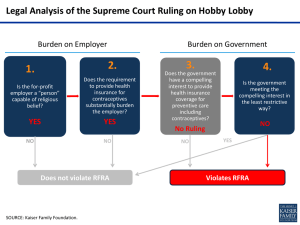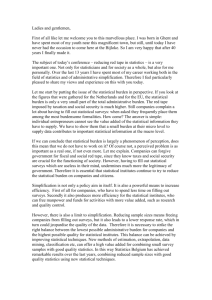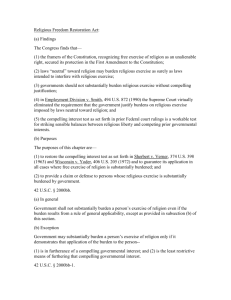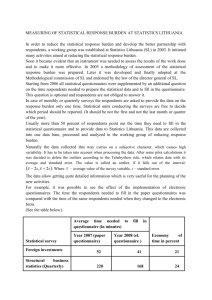labor burden - the Texas Department of Transportation FTP Server
advertisement
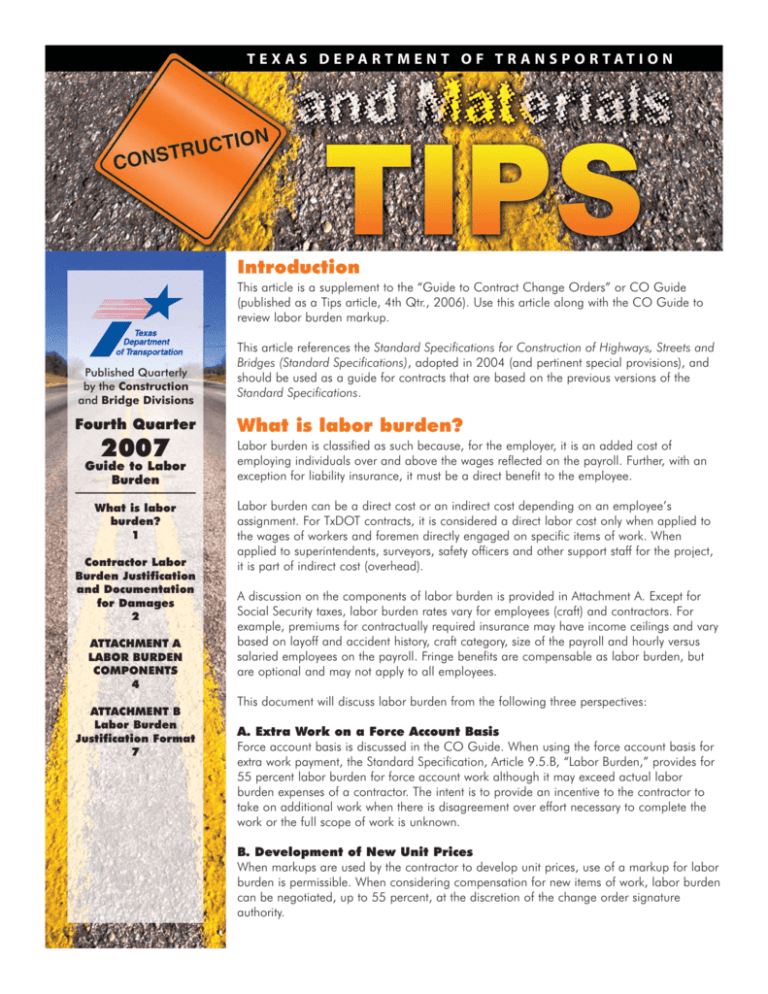
T E X A S D E PA R T M E N T O F T R A N S P O R TAT I O N Introduction This article is a supplement to the “Guide to Contract Change Orders” or CO Guide (published as a Tips article, 4th Qtr., 2006). Use this article along with the CO Guide to review labor burden markup. Published Quarterly by the Construction and Bridge Divisions Fourth Quarter This article references the Standard Specifications for Construction of Highways, Streets and Bridges (Standard Specifications), adopted in 2004 (and pertinent special provisions), and should be used as a guide for contracts that are based on the previous versions of the Standard Specifications. What is labor burden? 2007 Labor burden is classified as such because, for the employer, it is an added cost of employing individuals over and above the wages reflected on the payroll. Further, with an exception for liability insurance, it must be a direct benefit to the employee. What is labor burden? 1 Labor burden can be a direct cost or an indirect cost depending on an employee’s assignment. For TxDOT contracts, it is considered a direct labor cost only when applied to the wages of workers and foremen directly engaged on specific items of work. When applied to superintendents, surveyors, safety officers and other support staff for the project, it is part of indirect cost (overhead). Guide to Labor Burden ________________ Contractor Labor Burden Justification and Documentation for Damages 2 ATTACHMENT A LABOR BURDEN COMPONENTS 4 ATTACHMENT B Labor Burden Justification Format 7 A discussion on the components of labor burden is provided in Attachment A. Except for Social Security taxes, labor burden rates vary for employees (craft) and contractors. For example, premiums for contractually required insurance may have income ceilings and vary based on layoff and accident history, craft category, size of the payroll and hourly versus salaried employees on the payroll. Fringe benefits are compensable as labor burden, but are optional and may not apply to all employees. This document will discuss labor burden from the following three perspectives: A. Extra Work on a Force Account Basis Force account basis is discussed in the CO Guide. When using the force account basis for extra work payment, the Standard Specification, Article 9.5.B, “Labor Burden,” provides for 55 percent labor burden for force account work although it may exceed actual labor burden expenses of a contractor. The intent is to provide an incentive to the contractor to take on additional work when there is disagreement over effort necessary to complete the work or the full scope of work is unknown. B. Development of New Unit Prices When markups are used by the contractor to develop unit prices, use of a markup for labor burden is permissible. When considering compensation for new items of work, labor burden can be negotiated, up to 55 percent, at the discretion of the change order signature authority. Construction and Materials Tips Guide to Labor Burden The allowance for negotiated markup up to 55 percent also applies to the adjustment of existing bid prices, unless the adjustment is categorized as reimbursement for damage. Refer to the CO Guide for further discussion on development of unit prices. C. Damages for Delays, Inefficiencies, Disruptions, and Accelerations As stated in the CO Guide, for delay damages, the department is obligated to pay actual costs including only the actual payroll burden. The 2004 Standard Specifications without Special Provision, Article 4.4.A., “Delay Claims,” states: The intent of paying for delay damages is to reimburse the Contractor for actual expenses arising out of a compensable impact. No profit or force account markups, other than labor burden will be allowed. Effective on all projects beginning with the March 2008 letting, Special Provision 004–012, Article 4.4.A., “Damages,” replaces Article 4.4.A., “Delay Claims.” The special provision states: For contractor damages, the intent is to reimburse the Contractor for actual expenses arising out of a compensable impact. No profit or markups, other than labor burden, will be allowed. The department’s position, supported by court opinions, is that contractors should not profit from damages. Profit is included in work performed and a profit on damages would provide an incentive for contractors to maximize damages. The contractor is obligated to mitigate damages. The department’s intent is to make the contractor whole; as a result, only actual labor burden is considered compensable for reimbursement of damages. The goal of paying “actual” labor burden is simple in concept, but difficult in practice. The amount of time and effort on the part of contractor and district personnel in seeking detailed breakdown of actual labor burden costs may not be warranted in all cases. The department has reviewed actual labor burden from numerous sources and has developed a fair and simple approach to addressing the actual labor burden markup by establishing a maximum value and requiring contractor submissions for request above the maximum value. Special Provision to Item 4 in the 2004 Standard Specifications: For damages, labor burden will be reimbursed at 35 percent unless the Contractor can justify a higher actual cost. Justification for a higher percentage must be in accordance with the methodology provided by the Department, submitted separately for project overhead labor and direct labor, and determined and submitted by a Certified Public Accountant (CPA). Contractor Labor Burden Justification and Documentation for Damages Beginning with the March 2008 letting, contractors have the option of submitting their company-wide labor burden markups to the Construction Division for statewide use. Contractor submissions must be separated into company-wide rates for project overhead staff and direct labor. The rates must be developed and submitted by a certified public accountant (CPA). Contractors may use a CPA they employ or a third-party CPA. If a third-party CPA is used, the submission should be forwarded by the contractor. The format requirements for CPA submissions and responses to questions will be provided by the Construction Division. A contractor who chooses not to submit their company labor burden will receive a maximum 35 percent for reimbursement of damages for labor burden. Under unusual circumstances, the department may consider project specific CPA-submitted rates. CPA-developed and submitted labor burden rates will also be accepted for resolving necessary contract adjustments for contracts let prior to March 2008. Attachments A and B are the basic formats for CPA use. Districts may use the information in the attachments to verify specific items of compensation are not duplicated. Only the labor burden rate submissions accepted by the Letting and Prequalification Branch should be used. A few examples of review issues include: ² Project overhead staff should be separated from direct labor and not duplicated. ² Leave pay may sometimes be included as a contractor’s direct reimbursement request and further should be prorated for the damage period. Districts forward the submissions to CST. CST will review and file submissions with the prequalification records. For competition reasons and at the contractors’ request, submissions are kept confidential; therefore, the records will be kept in 2 Construction and Materials Tips Guide to Labor Burden the prequalification files only. When labor burden rates are needed for settlement purposes, districts should request the values from CST through the CST Field Engineers or directly from the Prequalification Branch. 3 Construction and Materials Tips Guide to Labor Burden ATTACHMENT A LABOR BURDEN COMPONENTS This document provides reference information on labor burden components, their eligibility as labor burden and basis of cost for each component. Labor burden may be divided into statutory labor burden and compensable insurance (required insurance and taxes) and optional benefits (fringe benefits) provided to employees. Statutory Labor Burden and Compensable Insurance ² Social Security Tax – The total burden for Social Security is 7.65 percent. This tax has two components “OASDI” (Old Age, Survivor and Disability Insurance) and “Medicare.” The tax rates are a percentage multiplier of the individual wages (base plus overtime and shift differentials) up to an annual income ceiling for the OASDI portion (no income ceiling for the Medicare portion). The income ceiling has gradually increased over the years and is currently (2007) fixed at $97,500. Only the employer’s share of these taxes, 6.20 percent (OASDI) and 1.45 percent (Medicare), respectively, for the two portions is considered reimbursable. It applies to total dollars paid to the employees and, therefore, the percentages shown are applied to straight and overtime total dollars paid. ² Unemployment Insurance – The burden for unemployment insurance ranges from 0.1 percent to 4 percent of total payroll. The premium is a percentage multiplier of the individual wages up to an income ceiling. The premium has a federal component, Federal Unemployment Tax Act (FUTA), and a state component, commonly referred to as SUTA. The state component varies from employer to employer based on a contractor’s layoff experience. The SUTA unemployment insurance tax rate ranges from 0.3 percent to 8 percent of the individual’s base wages up to an income ceiling of $9,000. The federal tax is 0.8 percent up to an income ceiling of $7,000. Once an employee reaches these income ceilings no more tax is required until the next fiscal year. This burden’s cost should be distributed to the employee’s wages for the year. ² Workers Compensation Insurance – From reviewing data, the overall payroll rate varies from 2.5 percent to 10 percent. The premium, wholly paid by the employer, is in dollars per hundred dollars of total payroll of a craft category. The standard schedule for the premium varies with the classification of the employee and the employer’s accident record. It is assessed on the total payroll of an employer. In Texas, workers’ compensation insurance premium standard rates generally vary from 0.5 percent for non-craft employees (e.g., office workers) up to 18 percent for construction craft categories. There are rare cases of rates for marine construction work; the rate can be as high as 26 percent. These values are further adjusted for other issues such as additional surcharges for terrorism premiums; paid deductibles; contractor size; waivers of subrogation; dividends (refunds) received; and increased labor liability insurance a contractor may carry. Typical average premium for a roadway classification worker is around 9 percent; for bridge classifications it is close to 18 percent. Premium for overtime or late shift hours are based on straight time wage rates. Standard rates are used initially; however, contractors with low (accident) experience modification ratings (EMRs) will receive reduced premiums after three years. EMRs, vary from 0.2 to over 2, are factored on the adjusted worker compensation rate maintained by the Workers Compensation Commission. Because the actual rates are not fully compiled for up to three years, a historically based value can be used to establish the rate. The values should be submitted separately for project overhead staff and direct labor. 4 Construction and Materials Tips Guide to Labor Burden ² Contractually Required Insurance and Umbrella Policies – These company insurance policies are not labor burden. The department has chosen to include these in labor burden to simplify compensation procedures and remain consistent with Article 9.5.B. The contractually required insurance is the comprehensive general liability insurance for the minimum limits of liability required by TxDOT contracts. The premium, wholly paid by the employer, is per $1,000 of the onsite payroll or per $1,000 of total construction hard cost. The U.S. Labor Department does not recognize it as a benefit to employee; however Standard Specifications provides for the premium as labor burden. Umbrella policies are for liability over and above that contractually required and are not an employee benefit. However, for simplicity, both umbrella and contractually required insurance policies are considered permissible for payment as labor burden. Rates for Public Liability Insurance vary from 4 percent to greater than 10 percent of total payroll. Rates for umbrella policies vary from less than 1 percent to over 4 percent. ² Additional Liability Insurance – Additional liability insurance may be compensable as labor burden provided the policy is not required by special provision for a specific project. Examples are Pollution and Terrorism. Additional liability insurance required by special provisions or for a specific project is considered project overhead, not labor burden, such as: Railroad, Marine, Builders’ Risk, etc. Optional (Fringe) Benefits Costs of optional (fringe) benefits are compensable if they are provided as an established policy and available to all qualified individuals. TxDOT contractors may provide some of these benefits to the hourly labor force; some contractors provide these benefits to their salaried employees only. The U.S. Labor Department classifies the following optional benefits as labor burden. The values are to be submitted separately for project overhead staff and direct labor. ² Paid Holidays, Vacation, Sick and Other Absences – The cost for these benefits ranges from 0 percent to 9 percent of wages. The burden should be calculated at the rate earned, per hour or per month, and applied as a percentage of base pay rate. Leave hours taken should not be shown on payrolls or used as basis for other adjustments to the contract; this would create duplicate compensation. ² Employee Insurance (Life, Health, Short and Long-Term Disability) – The cost for these benefits ranges from 0 percent to 12 percent of wages. Premium rates depend on individual plans and are shared by employer and employee. Only the employer’s contribution should be considered as burden. ² Retirement and Savings (such as 401(k)) – The cost for these benefits ranges from 0 percent to 10 percent of wages. There are a variety of pension plans and they are mainly contributory. Some companies make contribution to employee’s account, some do not. Only employer’s contribution should be considered as burden. ² Employee Stock Ownership Plan (ESOP) – Contributions range from 0 percent to 6 percent. This is a defined contribution plan allowing employees to become owners of the company they work for in proportion to their service, salary or title. An ESOP eligible for reimbursement is not a profit sharing plan. Employer’s contribution to the trust proportional to the employee costs included in the pricing is compensable if it is an established plan for all qualified employees. Dividends from ESOPs are not eligible for reimbursement; this is a profit. ² Bonuses – Bonuses range from 0 percent to 2 percent. Bonuses are compensable as labor burden (direct or indirect cost) if they are distributed as a fringe benefit regardless of company’s financial performance and not as dividends. Employee quality and production bonuses are eligible if they are established by company policy or the bonuses are provided routinely regardless of the company’s profit. 5 Construction and Materials Tips Guide to Labor Burden ² Safety Incentives – Safety incentives range from 0 percent to 1 percent. These incentives are eligible as labor burden. “Tailgate” safety training (short duration meetings before work begins) conducted on the project for project staff and company safety training are not considered labor burden. The short tailgate meetings are billed as direct wages for items of work. ² Training and Safety Programs – Only those training and safety program costs directly associated with the employee are eligible as labor burden. Overhead for safety staff and their incidentals are not eligible as labor burden. Components Not Eligible for Reimbursement as Labor Burden The following expenses do not constitute or are not separately compensable as labor burden. ² Additional Liability Insurance – Additional liability insurance may be required by special provisions for a specific project for an individual contractor, such as: Railroad, Pollution, Marine, Builders, etc. Premiums for these additional liability insurance policies are not an employee benefit, usually purchased project specific, and not compensable under labor burden. ² Auto Liability Insurance – Auto liability insurance policies are not an employee benefit and therefore not compensable as labor burden. Additionally, liability insurance is a component of the Blue Book Rental Rate. Payment as labor burden or overhead would represent a duplication of payment. ² Overtime or Premium Rates (weekends/holidays and shift differential) – While overtime or premium rates are employee benefits, they should already be included in the wages. ² Profit Sharing Plans, Gain Sharing Incentive Plans and Bonuses Distributed as Dividends – These expenses are viewed as a distribution of profits and are not compensable under labor burden. ² Lodging, Meals, Per Diem – These expenses are viewed as project overhead expenses, not labor burden. 6 Construction and Materials Tips Guide to Labor Burden ATTACHMENT B Labor Burden Justification Format All submissions require separate values for project overhead staff and direct labor unless otherwise stated. Component Submission Criteria Social Security and Medicare The rate is 7.65%. Same value will apply to both project overhead staff and direct labor. Unemployment Insurance Divide total yearly unemployment premium by total salaries. Rates determined for the most recent year satisfy the submission requirement. Same value will apply to both project overhead staff and direct labor. Workers Compensation Insurance Company-wide composite rate over most recent 3 years. Public Liability Insurance and Umbrella Policy Company-wide composite rate over most recent 3 years. Paid Holidays, Vacation, Sick and Other Absences Use leave accrual rates to calculate a combined leave rate that is supported by company policy. Rates determined for the most recent year satisfy the submission requirement. Employee Insurance (Life, Health, Short and Long Term Disability) Employer share of premiums for participating employees divided by total salaries to calculate a company-wide composite rate for most recent year. This must be supported by company policy. Retirement and Savings Employer contribution for participating employees divided by total salaries to calculate a company-wide composite rate for most recent year. This excludes profits or dividends and must be supported by company policy. Employee Stock Ownership Program (ESOP) Employer contribution for participating employees divided by total salaries to calculate a company-wide composite rate for most recent year. This excludes profits or dividends. Bonuses Employer contribution for participating employees divided by total salaries to calculate a company-wide composite rate for most recent year. This excludes a distribution of profit or dividends and must be supported by company policy. Safety Incentives Employer contribution for participating employees divided by total salaries to calculate a company-wide composite rate for most recent year. This must be supported by company policy. Training and Safety Programs Safety training and other employee training. Employee training time is compensable if it is a discrete training session and if it is separate from project labor hours. Examples: On-the-job training is considered direct labor cost and not labor burden; 15-minute tailgate safety meetings are direct labor and not labor burden. 7


